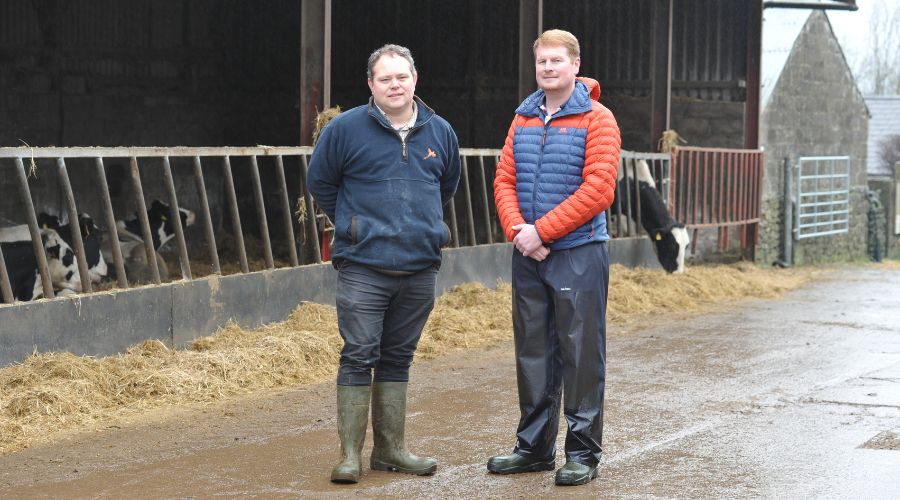Welsh farmer reveals top biosecurity tips on protecting cattle from TB
17th February 2025
A dairy farmer managing a chronic bovine TB breakdown has eliminated a major disease threat to his herd by no longer buying in cattle.

Michael Williams is one of 15 farmers involved in the Pembrokeshire TB pilot, a Welsh Government initiative that aims to develop additional measures for bovine TB control, over and above the statutory actions currently being used.
Sharing his progress with other farmers at a recent Farming Connect event, Mr Williams said there is much that every farmer can do to protect their herds from TB.
He has introduced multiple biosecurity measures, including running a closed herd. The farmer milks 150 cows on a robot milking system at Fagwrfran East, Puncheston, and had sourced cattle from livestock markets, but this came with the risk of importing TB.
He explained: “We had already stopped buying in cattle before becoming part of this project but we have since become a truly closed herd, we don’t even buy a stock bull.”
Introduced measures
Mr Williams added that cameras were installed to establish if badgers were coming into contact with cattle in the yard and housing and with food and water sources.
None were detected, but there were obvious physical signs of activity in fields and on cow tracks.
One and a half miles of badger-proof fencing has since been erected along a hedge with a high number of setts and latrines to separate these from the stock.
Mr Williams has introduced other measures too, which include:
Creating a remote fallen stock area
The fallen stock collection point had been situated on a part of the farm, which compelled a vehicle to cross the yard to collect carcasses.
This facility is now located in a contained area of a building that sits closest to the road and can be completely sealed off from wildlife.
Erecting electric fencing along the maize clamp
Although the farm has no feed bins vulnerable to wildlife, its open maize clamp is a potential risk at feeding out.
Mr Williams erected a simple deterrent, filling two redundant 20-litre dairy chemical drums with sand, placing these at each end of the clamp face, and running polywire from one to the other, hooked up to a solar-powered energiser.
“This cost about £20, took ten minutes of my time, and prevents badgers from interfering with the feed,’’ he said.
Restricting visitor numbers
Unplanned visits by sales representatives and others are now discouraged.
Visits are by appointment only, and a sign has been placed at the farm entrance advising of this policy. Vehicles coming onto the farm must be clean.
Draining unused water troughs
In-field drinking water troughs that are not used in the winter when the herd and youngstock are housed are drained and remain empty until turnout. Water troughs in use are cleaned weekly.
Reducing reliance on farm contractors
Investment has been made in slurry application equipment to remove the need for hiring contractors for this job.
Keeping cattle accommodation walkways clean
The frequency that feed passages in the cattle housing are cleaned has increased to minimise the period that slurry pools in these locations.
Adopting the highest level of hygiene at calving
Matting similar to cubicle bed mattresses has been laid in a dedicated calving pen to allow the floor to be thoroughly pressure washed and disinfected between calvings.
Providing footwear disinfection points
Containers of disinfectant solution are positioned around the yard to allow footwear to be disinfected in between contact with different classes of stock
Increasing intervals between slurry application and silage harvesting
Although Mr Williams operates a multi-cut silage system, he has increased cutting intervals from four weeks to five and applies slurry to the aftermath at the very earliest opportunity, the day after the grass has been collected from the field.
Other measures
In addition to rolling out biosecurity measures, Mr Williams has been culling animals that have been identified as at high risk of contracting or spreading TB, flagged up on a ‘risk rating’ list through an app developed for the Pembrokeshire TB pilot.
Any cow in the two highest risk categories – in this case, red or amber – is sold as barren.
“Being more proactive with culling, choosing when an animal leaves the farm rather than being in a forced situation as a result of a TB test, is a better option in many ways,’’ Mr Williams said.
If an animal falls into a ‘yellow’ band, the lowest of the three risk categories, but is nonetheless a risk, she is bred to a terminal sire to ensure that no female replacements enter the herd.
In 2024, 35 of Mr Williams’ cows exited the herd based on risk rating results.
He explained: “There is short-term pain in getting on top of the residual disease, but I am confident that we will reap the rewards a few years down the line.
“If we can get down to two or three percent risk rating, we will be in the realms of being on top of the disease rather than the disease being on top of the herd.’’
He believes this system is working. “In December 2024 the risk rating was 7% compared to 11% in January 2024, so this is a start. We think culling is working,” the farmer continued.
Mr Williams also emphasised the importance of making time to discuss biosecurity and disease risks with the farm vet.
“Don’t do this while the vet is TB testing or on the farm for another reason, set aside a dedicated time to have a proper discussion,’’ he advised.
Mr Williams credits his vet, Rhiannon Lewis, of Gwaun Vets, with supporting him through this process. “We have worked together on this,’’ he concluded.
Read more livestock news.
